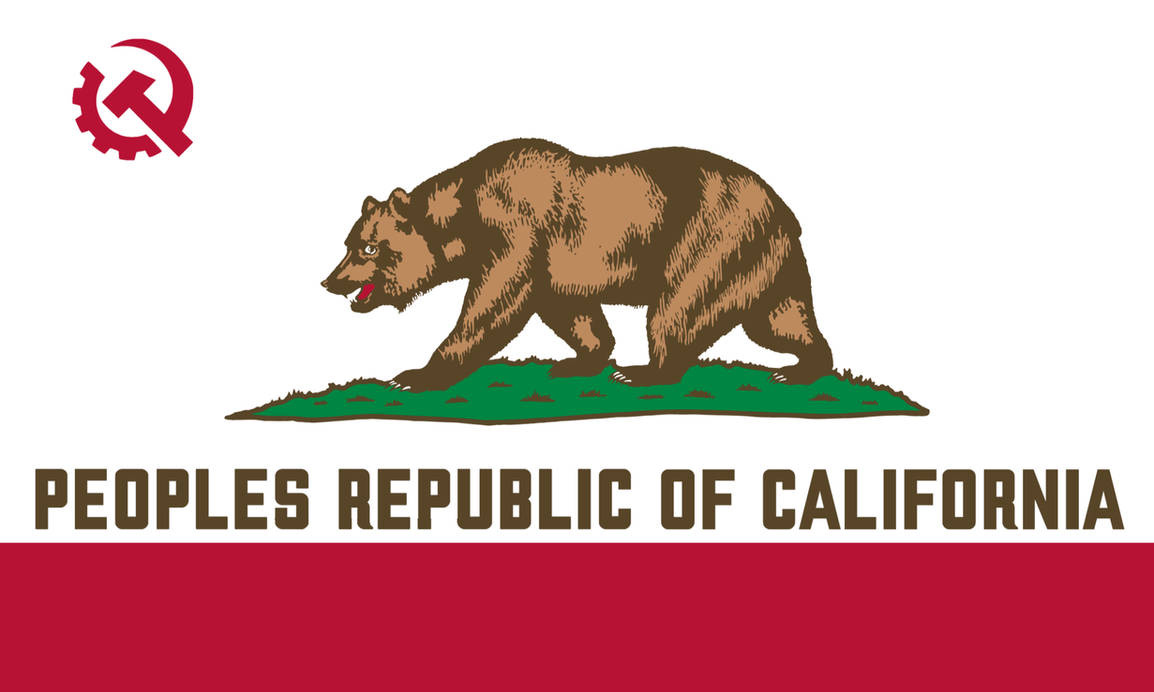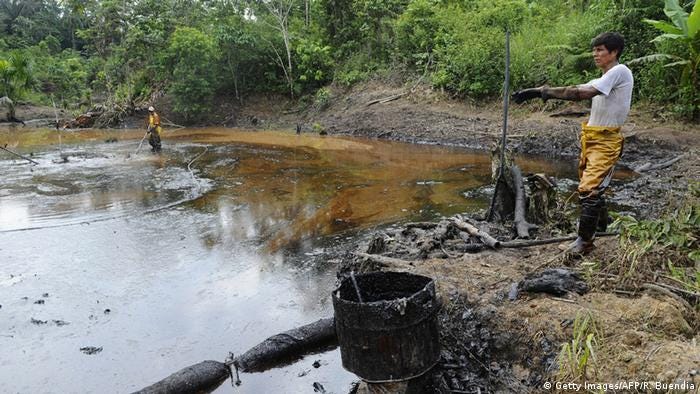Gavin Newsom's Crude Reality: California Dependent on Oil from the Amazon Rainforest
California consumes over 50 % of Ecuadorian rainforest oil, but China aims to take over
Biodiversity be damned, this report reveals that California is biggest consumer of oil extracted from the Ecuadorian rainforest
TC’s side note: Gavin Newsome has curtailed production of CA heavy crude oil, so now CA must import the same from the Amazon
Rich Schapiro, Christine Romo and Santiago Cornejo
This article was produced in partnership with the Pulitzer Center’s Rainforest Investigations Network.
YASUNÍ NATIONAL PARK, Ecuador — The bulldozers rumble through after sunrise, clearing out massive amounts of trees in this remote and remarkable section of the Amazon rainforest.
It’s a place where giant otters patrol the waterways and endangered white-bellied spider monkeys swing from tree to tree. Where a dazzling array of birds — upward of 600 species — nest in the dense canopy. Where more than 60 kinds of snakes and 140 different frogs and toads inhabit the ground below.
The Yasuní National Park is home to one of the most diverse collections of plants and animals on the planet. But beneath this 3,800-square-mile swath of forest lies another kind of treasure: crude oil. More than 1 billion barrels of it.
Over the past 50 years, oil companies have extracted immense amounts of crude from the Amazon, causing the destruction of rainforest crucial to slowing climate change and jeopardizing the Indigenous tribes who rely on it.
“It hurts me to see the little that is left of our rainforest inside this protected area,” Nemo Guiquita, a leader of the Waorani tribe, told NBC News during a boat trip through the national park. “We should be fighting to protect our rainforest in Ecuador, but instead they are granting more oil concessions.”
The oil extracted from Yasuní and the wider Amazon is exported around the world, but 66 percent goes to the U.S. on average and the vast majority of that to one state in particular: California, according to a new report shared exclusively with NBC News.
“This is no longer one of those things where we’re supposed to have sympathy for a crisis that’s happening somewhere else,” said Angeline Robertson, a senior researcher at Stand.earth and the lead author of the report. “It’s occurring in California, and it’s linked to Amazon destruction.”
Oil boom and bust
Oil drilling in the Ecuadorian Amazon began in the 1960s with the promise of bringing prosperity to the coastal South American nation. A symbolic first barrel of crude oil was paraded through the streets of the capital city, Quito, as if it were a national hero.
Ecuador’s economy soared over the next decade. But by the 1990s, the oil boom had faded, and the country entered a severe recession, resulting in a flurry of deals with foreign oil companies and eventually mounting debt.
Ecuadorian President Guillermo Lasso, who was sworn in this past May, has vowed to double the country’s oil production. Perhaps nowhere is expected to be impacted more than Yasuní National Park.
Oil exploration began here in the 1970s, but in 2007 then-President Rafael Correa proposed a novel plan to protect the rainforest from drilling. He called on the international community to donate about $3.5 billion — roughly half of the revenue Ecuador estimated it would have earned from mining the oil under Yasuní. But the plan was abandoned six years later, after Ecuador raised less than 10 percent of the target figure.
Send cash Unkle Gavin, please?
“The world has failed us,” Correa said in 2013 as he announced a lifting of the moratorium on oil drilling in Yasuní.
The move to drill hundreds of new wells in the national park requires the building of roads and other infrastructure that is likely to accelerate deforestation, environmentalists say. Construction of an initial road inside the park is now less than 1,300 feet from the “no-go” zone designed to protect the uncontacted tribes, according to the report.
Kevin Koenig, the climate and energy director for Amazon Watch, noted that forests like this one play a vital role in mitigating climate change. Forests absorb immense amounts of carbon, which helps to reduce the rate at which carbon dioxide builds up in the atmosphere.
“It’s a recipe for climate disaster to be looking for new oil and felling standing forest to get at it,” Koenig said. “It’s sort of a double whammy that everybody should be really worried about.”
Gas flares
Nemo Guiquita, the Waorani leader, has been fighting the expansion of oil drilling in her tribe’s ancestral homeland for years. She said her grandmother, Nayuma, was the first Waorani to make contact with the outside world 60 years ago.
“The rainforest for us is home,” Guiquita said. “It’s our life, our pharmacy, our everything.”
Javier Solis, a lawyer who represents one of the local communities, said the government has yet to set a date for the removal of old flares. Solis escorted an NBC News videographer into a section of forest outside Yasuní to see what he described as one of the Amazon’s biggest oil flares.
“The contamination can reach a circumference of 300 meters [330 yards], and this affects the groundwater and rivers used by nearby communities,” Solis said.
Bermeo is keenly aware of the economic forces driving the expansion of oil drilling in the Amazon.
The Ecuadorian government owes more than $18 billion in debt to China, according to a database run by Boston University and the Inter-American Dialogue think tank, and oil revenues are critical to paying down the loans.
Ecuador has sold oil exploration rights in and around Yasuní National Park to a consortium of Chinese state-owned oil companies despite fierce opposition from Indigenous groups and environmentalists.
“The companies who profit are the Chinese oil companies,” Bermeo said. “The Ecuadorian oil companies subcontract to the Chinese for the exploration, drilling and infrastructure. They are the ones making the money here.”
The Chinese oil companies, Andes Petroleum and PetroOriente, did not respond to a request for comment.
The Ecuadorian Embassy in Washington also did not respond to a request for comment.
Where the oil goes
Ecuador is not the only South American country to export oil from the Amazon, but it far and away dominates the market, according to the report shared with NBC News.
Colombia and Peru accounted for roughly 7 percent of the total volume of Amazon oil exported around the world. Ecuador makes up the other 93 percent, the report said (Brazil and the other South American countries that contain the Amazon were not found to export any oil sourced from beneath it).
Last year alone some 70 million barrels of oil from the Amazon rainforest in Ecuador flowed to the U.S., making it the largest global consumer by far. Panama was second (almost 22 million) followed by Chile (13 million) and China (nearly 10 million), according to the report.
California accounted for nearly 56 million barrels, far more than the five other states that received it: Texas (6 million), Louisiana (6 million), Mississippi (0.5 million), Washington (0.4 million).
In a statement, the California Environmental Protection Agency said the state is investing more than $15 billion in its climate agenda, including $4 billion to accelerate the transition to zero-emission vehicles.
“We cannot sacrifice the habitability of our planet or the survival of vulnerable indigenous communities for a dying industry,” the agency said. “This report illustrates exactly why California must eliminate dependence on fossil fuels, whether they come from critical regions like the Amazon or next to homes and schools right here in the state.”
The report’s researchers tracked shipments of oil from beneath the Amazon to the U.S. and beyond by combing through records from the U.S. Energy Information Administration, the United Nations Comtrade database and import/export databases for Ecuador, Colombia, Peru, Brazil and the U.S.
The researchers also reviewed a host of other sources, including state and federal government databases and company reports, to calculate fuel consumption estimates for the amount of Amazon oil used by the U.S. companies highlighted in the report.
About half of the Amazon oil exported to California went to three refineries in and around Los Angeles, the report said.
Ed Hirs, an energy fellow at the University of Houston, said he’s not surprised that such a large amount of oil from the Amazon ends up in California given its proximity.
“It’s probably just transportation cost,” Hirs said. “It’s seven or eight days to California” from Ecuador “as opposed to weeks from the Middle East.”
Hirs said the report underscores a hard reality of the global marketplace for oil: Even if California were to stop consuming the crude from the Amazon, another country would merely take its place.
“I can’t argue with what they’re talking about in terms of the damage and environmental issues,” Hirs said. “Is it a problem? Absolutely. Can California do anything about it? No. For another 50 cents a barrel, that oil would just go someplace else.”
Robertson said she and her colleagues are not asking for California to immediately stop using oil from the Amazon, but she hopes government officials and corporate leaders take steps to reduce their dependence as part of an overall strategy to curtail the use of fossil fuels.
“It’s within the realm of the possible, and it’s part of the necessary,” Robertson said. “It should become something that is central to California’s climate crisis strategy.”



















Another great one, T.C. - love it!
This highlights a critical part of the oil markets: Not all oil is the same. There's so many different types of oil and they have different uses. The US has an abundance of light oil, which is particularly good for making lighter refined products - gasoline, for example.
Heavy oil has more of the long-chain molecules and is better for the 'bottom of the barrel' products such as heavy fuel for ships, petrochemicals, asphalt etc. The heavy oil can also be 'cracked' (broken down) to lighter oil products too.
I has a lot do with refineries too. Lighter oil needs less-complex refineries, in general. More complex refineries can handle heavier oil. So a lot depends on the refinery and the feedstock it needs.
Add it that heavy oil can be cheaper to produce, but harder to refine, it makes sense that complex refineries tend to favor heavier oil. They can make a wider range of products and fully use their complex refineries.
Most of Ecuador's oil is heavy or medium heavy. (API 19-24). Since the US doesn't produce much heavy oil, we export the excess lighter oil and in exchange, import heavy oil.
Ironically, the US could have imported more of its heavy like- oil from Canada Via the Keystone pipeline. The pipeline was designed to bring heavy dilutant (or very similar to heavy oil) down from Canada but President Biden blocked it to the cheers of the green movement.
However, we still need that type of oil... so where do we get it? The Amazon Rain forest... instead of Canada.